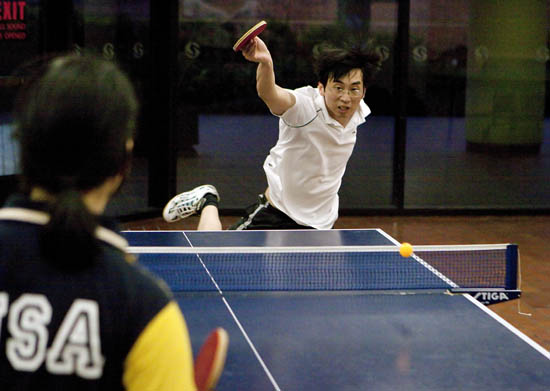The pingpong ball is a fixture of college life, most commonly used as a gateway to a night of inebriation.
But every Tuesday and Thursday night in the Wooden Center lobby, the UCLA Table Tennis club breaks out the tables and balls for its intended purposes.
The flurries of shots and displays of fancy footwork seen in the lobby are not meant to separate the pingpong enthusiasts from the casual crowd. Located at these tables is one of UCLA’s most accommodating sports clubs.
Created in 2003, the table tennis club has seen its ups and downs but has continued to grow. Despite having to battle for space availability and deal with funding issues and inconsistent management, the club has maintained its goal of being open to players of all levels.
“For people who want to learn to play, we’ll set them up with someone, and that person becomes their practice partner,” said Andrew Huynh, a third-year biology student and the club’s president. “They can teach them the basic strokes, basic spins, and how to understand the game.”
Though the club has just 20 active members, there is a compatible player for everyone. Less-experienced players are paired with more-experienced players so that they can gradually improve their game. Some of the most skilled members joined the club without ever picking up a paddle.
Alex Wong, a third-year computer science engineering student, saw the table tennis team practicing on his way to the basketball courts and was immediately drawn to the club, even though he had never heard of it.
“My first reaction was, “˜I didn’t even know there was a table tennis club,'” Wong said. “Just last year, our women’s team placed sixth in the nation. When I tell people that, they say, “˜Oh, I didn’t know that. How come that’s not in the paper? How come no one ever talks about table tennis winning championships?'”
Collegiate competition starts at the regional level, and tournaments consist of three leagues: varsity co-ed, women’s and junior varsity. Last year, both the varsity and women’s teams qualified for the National Collegiate Table Tennis Association championships, the largest collegiate tournament in the country.
“Most people don’t know about the competitive side of pingpong and that we actually play at a certain level,” Huynh said.
But for practices, Huynh said it’s important that the club allows players to both train for competition and play for fun, so tables are often designated to accommodate that.
However, because of an overwhelming interest in the sport, playing time is limited to the availability of the tables. The club has had trouble finding a larger area in which to play, and club sports rules prohibit the team from taking the tables outside the Wooden Center.
“It’s really a big issue,” said Chen Yang, a fourth-year bioengineering student and vice president of the club. “You get so many enthusiastic members coming in on the first day, but they see three tables and think, “˜Oh, only six people can play.’ They just get discouraged and stop coming.”
The club has access to four tables, but it is not allowed to put all of them in the Wooden Center lobby without obstructing the fire exits. The tables are owned by the Wooden Center, so the club is not allowed to reserve them on non-practice days. With only three tables available for two days, the players are forced to stretch their practice hours from 7 p.m. to 11 p.m., coming in at different shifts to play.
The club has also had issues with organization in the past. Yang said that previous administrations “started the club, but let it die off a little.” The table tennis team lost its club sports designation a few years ago after failing to submit the necessary paperwork.
“At the time, (Huynh) and I didn’t know because we were just regular members,” said Yang. “We just had to get everything starting again. We had to start from scratch, basically.”
But the change in administration has been fruitful. Both Huynh and Yang have helped the club grow into a contender in collegiate competition. One of their biggest contributions has been helping the club get more female players.
“When I started, there was no women’s league,” Huynh said. “The first year I took over (as president), the NCTTA said to try to make women’s teams, so we actively recruited at the Bruins’ activities fair.”
Stephanie Chow, a second-year communication studies student, has seen the number of female players grow since joining just a year ago.
“When I first joined, there were hardly any women, and now there are so many that our women’s team had to cut a few,” Chow said. “There are so many women that play at such a high level now.”
Chow, who played competitively during high school, knew about the table tennis club coming into UCLA and actively sought it out in order to join. Chow said that the openness of the club’s members has helped her develop friendships.
“Chen and Andrew and the team were all really inviting,” she said. “They took the time and energy to talk to everyone who visited the club. I felt welcomed and I had a lot of fun, so I kept coming back.”
So as the club continues to battle for more room and funding, the members will try to continue working on what’s most important for the club.
“The club basically has two main goals,” Yang said. “One is to build friendships, making sure everyone is happy with each other. The second is just to have fun, to just play table tennis.”
